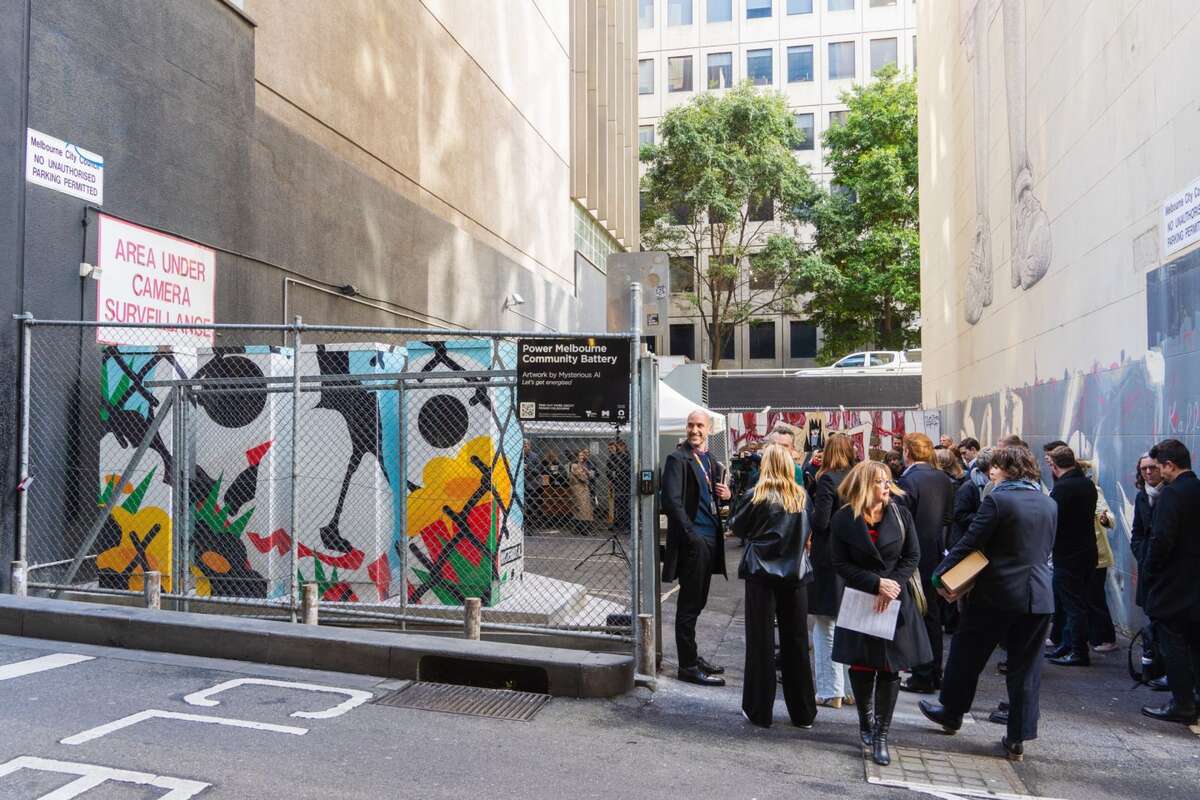Fossil fuel enthusiasts, when defending their carbon emitting industry, love saying that the wind doesn’t always blow, and the sun doesn’t always shine. It’s a tired phrase. They frame it as an obstacle to the green transition and a reason to not fully rely on renewable energy.
Anyone working in the transition, however, knows full well that we can store that wind and solar power for later use. It’s not fleeting, as fossil fuelers imply. It’s storable. Now, cities around the world are getting into the storage game, rolling out batteries across neighborhoods and communities. Batteries that charge during the day, when renewable energy is shining and blowing, and then release that stored energy when and where it’s needed most.
Melbourne, Australia, is approaching this process collaboratively with the community, as both a teaching tool and a way to ensure that any battery designs, locations, and uses have neighborhood buy-in. It’s all part of a campaign called Power Melbourne that’s helping to aid in the city’s transition to 100% renewable energy by 2030. And while the council’s operations are already powered by 100% renewable energy, the city facilitates energy power purchase agreements for businesses to also tap into abundant local renewable energy, like wind power.
Employing a wide array of approaches—including creative animations, individual surveys, community champions, and cross-council collaboration with neighboring cities—this multiyear effort illustrates how serious the city is about building public and political will for this work. In short, they’re in it for the long game—as is the Carbon Neutral Cities Alliance, where I work, which is why we’ve been so keen to support the work of our member Melbourne’s leadership in this space.
There are some interesting findings from Melbourne’s recent work, namely that communities aren’t just supportive of neighborhood batteries but have some great ideas for how to design, locate, and make multiple uses out of them. Here are just four of the takeaways from Power Melbourne’s process.
Cities need to roll the batteries out
Support for these batteries is overwhelming. In early surveying of residents and businesses, 89% agreed that community batteries are an important part of the solution in transitioning to more renewable energy. Another 77% of respondents were supportive of a community battery in their local area. That’s incredible. Residents increasingly understand that batteries help cut emissions and reduce pressure on the grid while benefiting communities with more affordable energy. And as the City of Melbourne heads toward a net zero emissions goal by 2040, this local support will be invaluable in rolling out more energy storage.
Make the batteries visible—and fun
Making the entire process visible to the community—both before, during, and after installation—is paramount. The batteries are roughly the size of four refrigerators, and they can store 354 kWh, which is equivalent to about 30 household battery systems. A highly visible battery in the neighborhood is a great conversation starter for families and friends. This is how cities can build community awareness and education about the transition to renewable energy. Further, have fun with it. Melbourne’s first installed battery system—covered in commissioned street art by local artist Mysterious Al and titled “Let’s get energized”—offers a far more engaging approach than a boring gray battery. And as additional batteries get rolled out this year in highly visible locations—like the Boyd Community Hub and the Library at the Dock—more of this kind of public engagement becomes possible.
Take advantage of underutilized spaces
Rather than eating up green space and public parks, Melbourne residents prefer other city properties for the pilot network of batteries. The city’s properties—like its recreation centers, libraries, and Queen Victoria Market—receive strong public support. These highly trafficked spaces lend themselves to being prime teaching tools and educational opportunities. Residents want the batteries to be a prominent feature of the city’s innovation in the renewable technology space. And they want the city to host displays and conversations at markets, libraries, and educational programs at schools. In other words, the community pride is strong.
Bring everyone into the process
Melbourne’s Community Champions were essential here. Volunteers from all backgrounds stepped up to learn more about community batteries and hold conversations within their professional and personal networks. Each engagement surfaced new questions, helping the city better understand residents’ motivations—what they care about and why—and anticipate and address concerns. More is always needed to ensure no one gets left behind this transition and everyone benefits. There are local energy equity concerns, for example, and a need to translate the tangible benefits to households less engaged.
One thing was clear from all this public input: Show how the individual battery will benefit the local community. Whether it’s channeling revenues from the neighborhood battery into a local community fund, providing a renewable electricity plan for residents that’s linked to the local battery’s revenues, or adding publicly accessible EV charging points at the battery site—make the benefits tangible. These are all great ideas for Melbourne to factor in as it scales up neighborhood batteries across the city.
What’s clear here is that communities need to be brought in on the ground floor, which is exactly what Melbourne did. Residents are ready to support the energy transition, they just want to be a part of its design and see its benefits.
Michael Shank is director of engagement at the Carbon Neutral Cities Alliance and adjunct professor at New York University’s Center for Global Affairs and George Mason University’s Carter School for Peace and Conflict Resolution. This article first ran in Fast Company.







![Tesla reviewer breaks down the price of owning an EV versus a gas car in the US: 'Real costs after one year [of] ownership'](https://energynews.today/wp-content/uploads/2023/06/yahoo_news_en-US_s_f_p_168x21_news-90x21.png)






